Russian battleship with a french flavor:
Without going into lowly humor mixing vodka and baguettes, the Tsessarevitch (or Tsesarevich) was the only capital ship of the Russian fleet entirely built in France. More importantly, she formed the basis for the Russian-built Borodino-class battleships (Or Slava). She underwent a rocky service life starting at Port Arthur, fighting the Russo-Japanese War of 1904–1905, the Battle of the Yellow Sea and later interned to Tsing-Tao, the Baltic Fleet, her crew mutinied in 1917 and she took part in the battle of the Moon Sound, seized by the Bolsheviks, fight for the “Reds” as Grazhdanin” and scrapped in 1924.
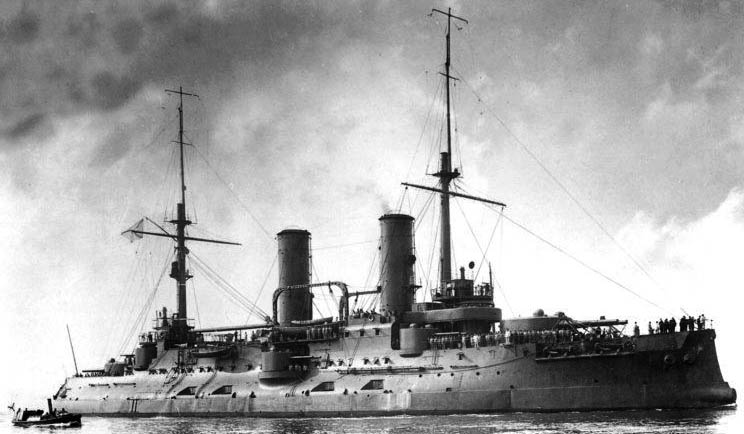
Tsesarevich – Unknown origin (pinterest)
Development of the Tsesarevich
The Tsar for longer desired a port in the Pacific, a warm-water port if possible for his fleet. At first, Japan gained access to the future Port-Arthur, as a prize for its victory at the First Sino-Japanese War of 1894–1895. However soon this was contested by Western powers (France, Russia, and Germany) and after a settlement whee Japan would obtain instead a raised indemnity, Russia eventually was granted a 25-year lease for what was renamed “Port Arthur”, which also comprised the whole Liaotung Peninsula in China. The Tsar then expressed the will to have a new battleship tailored to defend this harbor. However at that time, Russian shipyards were already at full capacity.
Therefore the naval ministry started to issue specification to several yards. After a short time, on 14 June 1898, the French yard Forges et Chantiers de la Méditerranée proposed a modified version of the Jauréguiberry. Quite quickly the Naval Technical Committee approved the design with changes agreed by the yard, leading to a signature on 20 July 1898 for 30.28 million francs (11.355 million rubles). It has competed over a proposal from the Baltic Works. The contract most important clause, however was its delivery time, 42 months, whereas all French battleship of the era nearly took ten years to be completed…
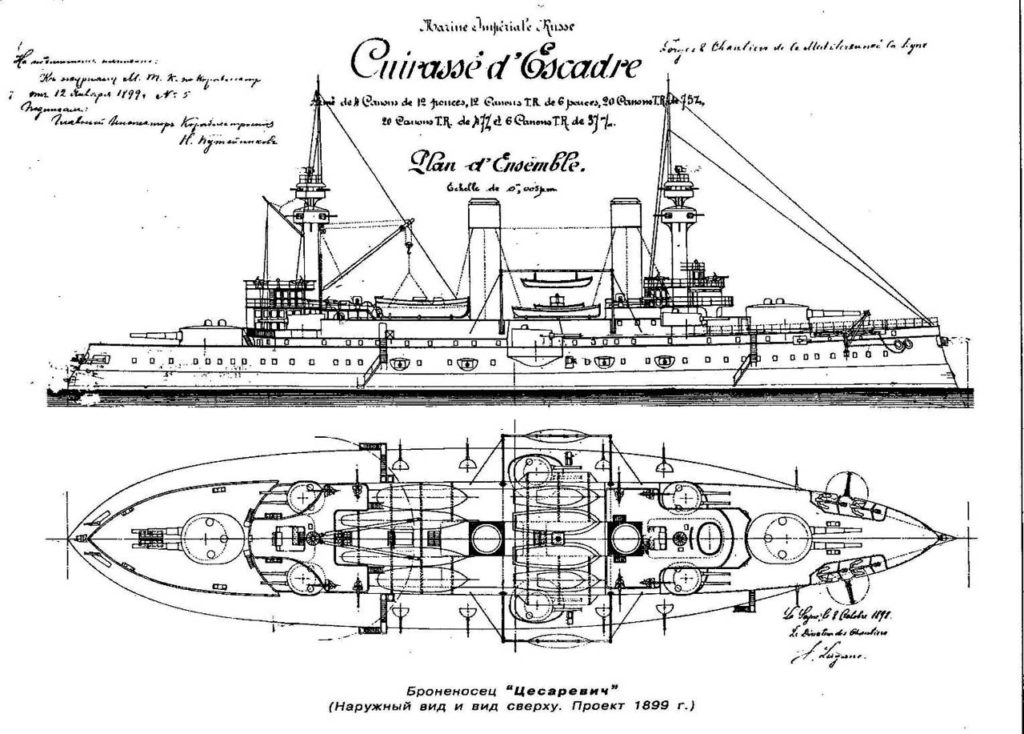
French blueprints of the Tsesarevich
About the name: “Tsesarevich” was a title adopted by the Romanov to discard the obsolete “Emperor” or “Tsar”, and it is associated with “Successor”, the heir, so to confer the meaning of “great prince”.
Design of the Tsesarevich
Where Tsesarevich is distinct from all other Russian battleships was her tumblehome hull. We already saw this French design oddity which had purpose: It allowed greater freeboard, reduced the structural weight and increased the field of fire of side-sponsons guns, and reduced the roll in heavy weather. The backflip where lower buoyancy and stability and excessive heel when turning. The impression was such that during the Battle of the Yellow Sea Japanese observers really believed Tsesarevich was about to capsize whereas she took a hard turn.
He hull was 118.5 metres (388 ft 9 in) long for 23.2 metres (76 ft 1 in) in beam, and 7.92 metres (26 ft 0 in) as draught, standard. Tsesarevich displaced 13,105 tonnes (12,898 long tons) and carried 28–29 officers plus 750 enlisted men.

HD blueprints (reconstructed) of the Tsesarevich. Src kombrig?
Powerplant
The beating hart of the ship were two vertical triple-expansion steam engines. They were fed by 20 Belleville boilers. The latter had working pressure of 19 kg/cm2 (1,863 kPa; 270 psi) and were fitted with economizers (for preheating). This allowed in theory to quick the process of heating boilers in case of emergency.
Indicated horsepower figures were 16,300 ihp (12,200 kW) and top speed as planned was 18 knots (33 km/h; 21 mph). However this design speed was exceeded on trial, Tsesarevich reaching 18.77 knots (34.76 km/h; 21.60 mph) with a total of 15,254 horsepower, less than the maximal figure. These speed trials took place in July–August 1903. The battleship carried 800 long tons (810 t) of coal in peacetime, ported to 1,350 long tons (1,370 t) in wartime. In total this allowed for a 5,500 nautical miles (10,200 km; 6,300 mi) radius at 10 knots (19 km/h; 12 mph). In addition, to run electrical devices on board, she was fitted with six electric generators cumulating of 550 kilowatts (740 hp), which were steam-driven.

Side details of Tsesarevich, showing the 12-inch turret and two of the 6-inch turrets. This was after reconstruction as shown by the pole masts and reduced superstructures prior to WW1
Armament
Main armament:
-Two turrets, with each a paired 40-cal. 12 in guns. The turrets were electrically powered, forward and aft. Both the guns and mountings were Russian-built. The turrets were French. The mountings allowed loading at all angles in elevation. However firing trials by heavy weather the ammunition hoists often jammed in case of excessive roll. New hoists were sent from France to Port Arthur, installed in January 1904. 70 rounds per gun were carried, and the guns were able to fire at an average rate of 90–132 seconds. Shells weighted 731.3-pound (331.7 kg) at a muzzle velocity of 2,598 ft/s (792 m/s), practical range was 16,010 yards (14,640 m) at 15°.
The secondary armament
Twelve Canet Model 1892 6-inch/45 (152 mm) Quick-Firing guns were installed. They were mounted in six twin-gun turrets, all on the upper deck, all electrically driven. They had a firing arc ranging from 150° for the corner turret and 180° for the center turrets. A provision of 200 rounds was made for each gun. Rate of fire was 2–4 rpm on average, for shells which were 91 lb (41.4 kg), exiting the barrel at 2,600 ft/s (792.5 m/s). Maximal effective range was circa 12,600 yards (11,500 m).
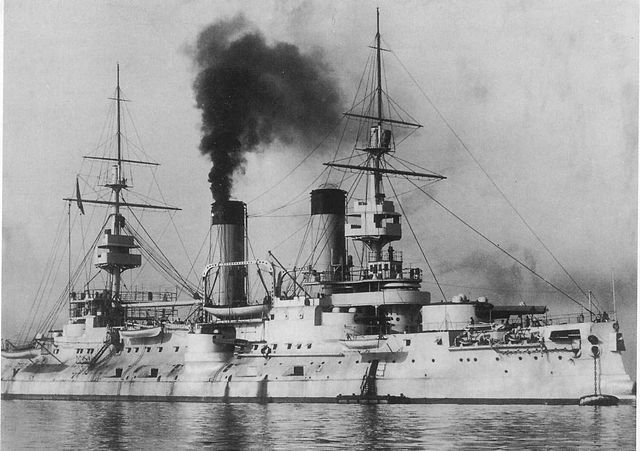
Tsesarevich making her debut trials at Toulon in 1903 before departing for the far east
Tertiary Armament
Small guns were carried to deal against torpedo boats:
-Twenty Canet QF 75-millimetre/50 (3 in) guns – 14 were installed in hull embrasures, six on the superstructure. 300 shells were carried for each gun. The shells weighted 4.9 kgs. Muzzle velocity was 2,700 ft/s (820 m/s), firing range was 7,005 yards (6,405 m) at 13°.
-Twenty 47-mm (1.9 in) Hotchkiss guns, all placed on the superstructure. They were provided by 2.2-pound (1.00 kg) shells. Muzzle velocity was 1,400 ft/s (430 m/s), rate of fire 15 rpm on average.
-Eight Maxim QF 37-millimetre (1.5 in) guns. They were placed in the superstructures and military masts. Their shells weighted 1-pound (0.45 kg), muzzle velocity was 1,319 ft/s (402 m/s).
The ship carried four 381-millimetre (15 in) torpedo tubes; two of these were mounted above water in the bow and stern, and the two broadside underwater tubes were located near the forward 12-inch magazine. Tsesarevich carried a total of 14 torpedoes. The ship also carried 45 mines to be laid to protect her anchorage in remote areas.
For targeting, the Tsessarevich was given two British Barr and Stroud coincidence rangefinders. Proper elevation and deflection were calculated and transmitted via a Geisler electro-mechanical fire-control transmission system to each turret. So in a nutshell, the Tsesarevich was French, with Russian armament, British fire control, and… German protection.
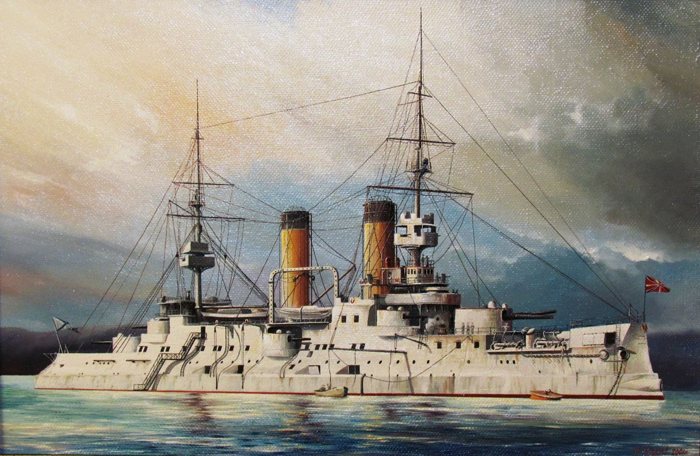
A painting of the Tsesarevich (origin unknown, from Pinterest) before the Russo-Japanese war
Armour
As a Pre-dreadnought battleship, Tsesarevich used a limoted size hull on which was plcaed a solid armour without yet any “all or nothing” scheme. The latest Krupp armor was used, in a version of the French cellular armor scheme. It was given a waterline armoured belt running all the way to the stern and bow, with two levels of successive armored decks, above and below the waterline. The “cellular” scheme concerned the part of the belt, 2 metres (6 ft 7 in) high, in between the waterline, which had well-subdivided compartments, usually empty or used to store coal.
Several could be breach without compromising the ship’s stability. The system was later proven on the Titanic, with the big difference there was not armored deck above the bulkheads. The belt was 250 mm (9.8 in) thick an 60 metres (196 ft 10 in) long (in between barbettes), reduced down to 180 mm forwards and 170 mm aft. It was tapered down to 170 millimetres on its bottom edge.
Above the belt there was a still impressive 1.67 m strake of armour, 200 mm thick, a bit shorter than 60 m and ending with 120-130 mm forward and aft.
Above this upper belt was an armored deck 50mm (2.0 in) thick, and below it, the lower armored deck (waterline) was made of two layers of 20 mm (0.79 in). It was not flat but curved downwards on its sides to the belt, connected to the low part of the belt by a 20 mm strake, forming a sort of torpedo bulkhead, 2 m from either side of the ship. It was 84 m long and backed by the cellular coal-filled rooms.
The main gun turrets and their barbettes were 250 mm thick, decreased on the roofs at 63 mm (2.5 in), whereas the lower part of the tubes were down to 100 mm. Secondary turrets sides were 150 mm (5.9 in) thick with a 30 mm roof. The conning tower had walls 254 millimetres (10.0 in) thick, a 63-millimetre roof and the communication tube below was down to 100 mm while the funnel uptakes were 19 mm (0.7 in) thick.
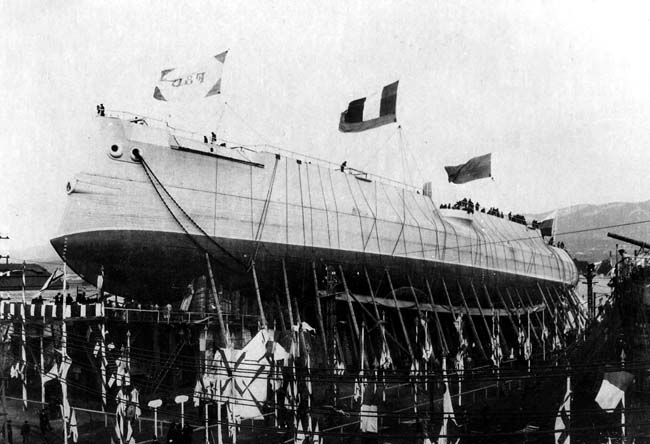
Launch of the Tsesarevich
The Tsesarevich in action
Tsesarevich was launched on 23 February 1901 and her construction has all along be supervised by Captain Ivan Grigorovich, her future captain. She entered service in August 1903, her first desitnation was to the Far East, Port Arthur, in which she arrived on 2 December 1903. At that time she was arguably the best Russian Navy’s battleship, and certainly the best asset of the Imperial fleet when the Russo-Japanese War broke out.
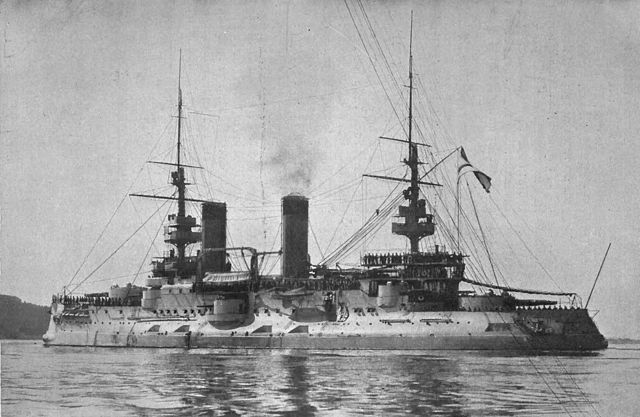
Tsesarevich in 1904
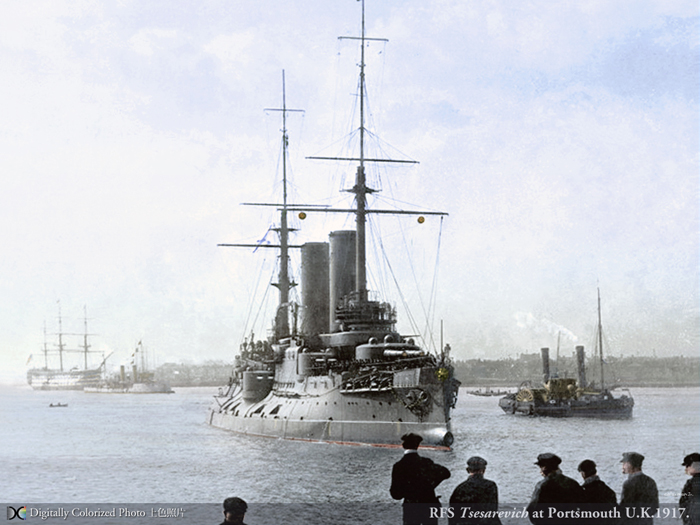
Tsesarevich in Portsmouth, colorized by Hirootoko Jr.
The Russo-Japanese war
Tensions indeed had grown steadily over shared ambitions on Manchuria and Korea, and both Japan and Russia made approaches, perhaps more ardent concessions on the Japanese sides and caution on the Russian sides at first, which were interpreted as bad faith, then a serie of actions or inactions on the Russian side which ultimately led the “falcons” in the Japanese government to attack first, as the decision was taken in December 1903 already.
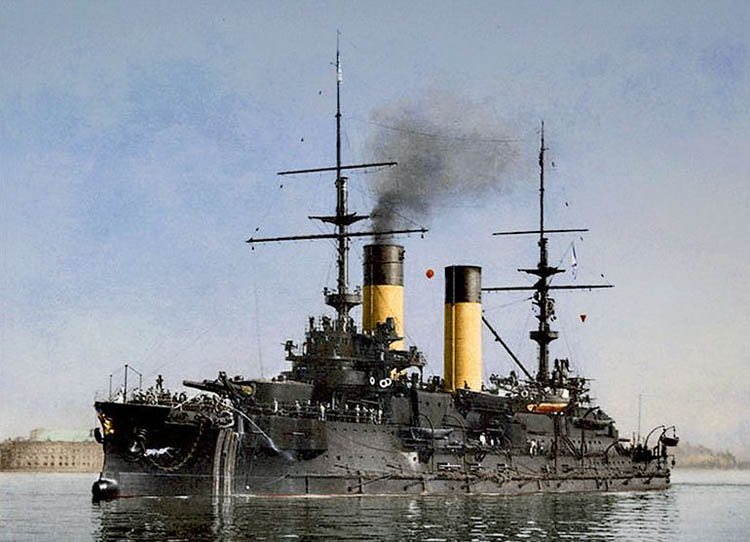
Tsesarevich at Port Arthur in 1904. By then she has been repaitned with black hull and superstructures
On the night of 8/9 February 1904, Japanese torpedo-boats were detached from the main fleet, entered the harbor (unprotected) and torpedoed the fleet. Tsesarevich was hit, just abaft the portside torpedo bulkhead. She took a 18° list, compensated by flooding the opposite compartments. This allowed to raise steam and the ship was later able to sail to the entrance of the harbor, but soon ran aground. She would be later refloated, conducted to the yard to be repaired over five months. This was achieved in June. In between she had been stripped of part of her guns, sent to the siege defensive works: Four 75-millimetre, two 47-millimetre and two 37-millimetre guns. This did not prevented the Japanese to raise their artillery above, 120 mm howitzes with which they started pounding the ships in teh areas, Tsesarevich included. She was hit hit twice on 7 August. One shrapnell hit Commodore Vitgeft.
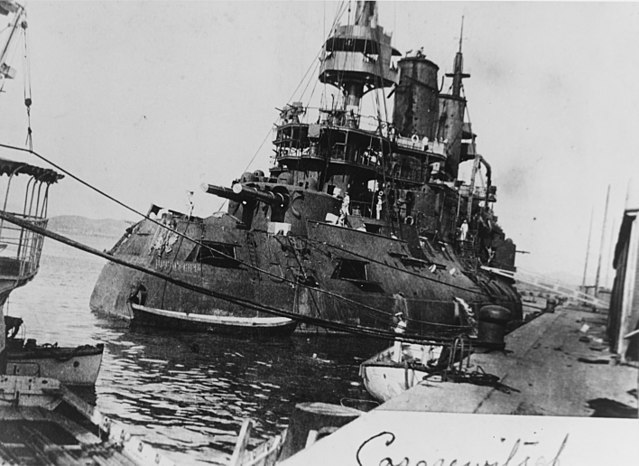
Battle damage at Port Arthur after torpedo hits
Battle of the Yellow sea
On 10 August, the fleet tried to exit the harbor and engage the Japanese fleet, break away ad sail to the safety of Vladivostock. As the best battleship of the pack, Tsesarevich led the line, followed by Retvizan, Pobeda, Peresvet, Sevastopol and Poltava. Vitgeft’s mark was raised on the Tsesarevich. The battleline was surrounded and screened by four protected cruisers and eight destroyers. Soon they met Tōgō’s fleet. However the line’s top speed soon fell to 13 knots, while Tsesarevich and Pobeda suffered mechanical problems. However the exchanged started at 13:25 with the Japanese concentrating on Tsesarevich and Retvizan, but breaking away since the Russian counter-fire was dense and accurate.
Togo broke at 15:20 and returned at 17:35, however soon the Russians had some advance and a half-hour of daylight left when Tsesarevich was hit by two heavy caliber hits on the conning tower at 18:40. Fragments bounced up and crossed the unprotected bridge, which was destroyed, killing instantly Vitgeft and his staff and the helmsman. With the lead ship without head, turning to port with the steering wheel jammed, the entire line followed. This was a disaster, ruining all chances to escape, and again Tsesarevich was targeted y the Japanese line to the point that Retvizan broke formation and charged to divert attention. On board Tsesarevich, Rear Admiral Prince Pavel Ukhtomsky, the second in command then alive ordered to repair the jammed steering, and succeeded. He asserted command and signalled them, just before darkness flell, back to port Arthur. Meawnhile Tsesarevich still tried to reach Vladivostok during the dead of night but eventuallt took refuge in the German colony of Tsingtau.
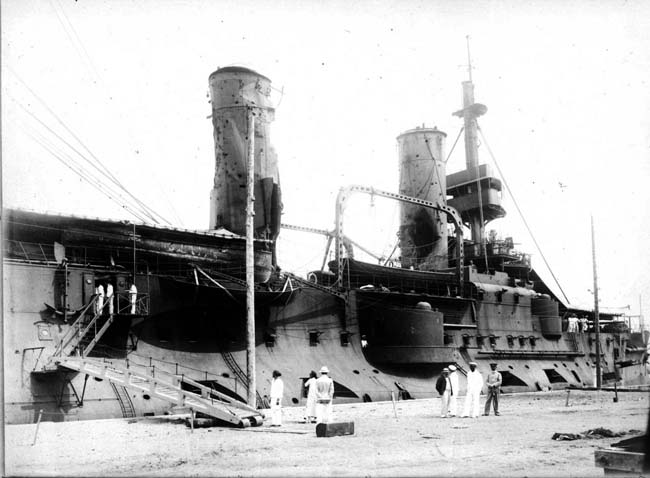
Battle damage after the Yellow sea, in Tsingtau
The Tsesarevich in WWI
After summary repairs at Tsingatu and the end of the war, Tsesarevich escaped the fat of many Russian ships of the day, notably capture, and she was transferred to the Baltic fleet in early 1906. One of her first actions was to suppress the Sveaborg Rebellion on 1 August 1906. Later she underwent an overhaul, mostly to save some top weight and regain stability: The fighting top were replaced by simple masts, superstructure cut down, as well as 75 mm platforms. She usually spent her winters in the Mediterranean, and saved refugees at the Messina earthquake in December 1908. In 1909 a second wave of modifications started: Her machinery was overhauled, boilers and steam engines changed, and later her casemated 75 mm guns on the lower hull were removed and the spaces welded shut.
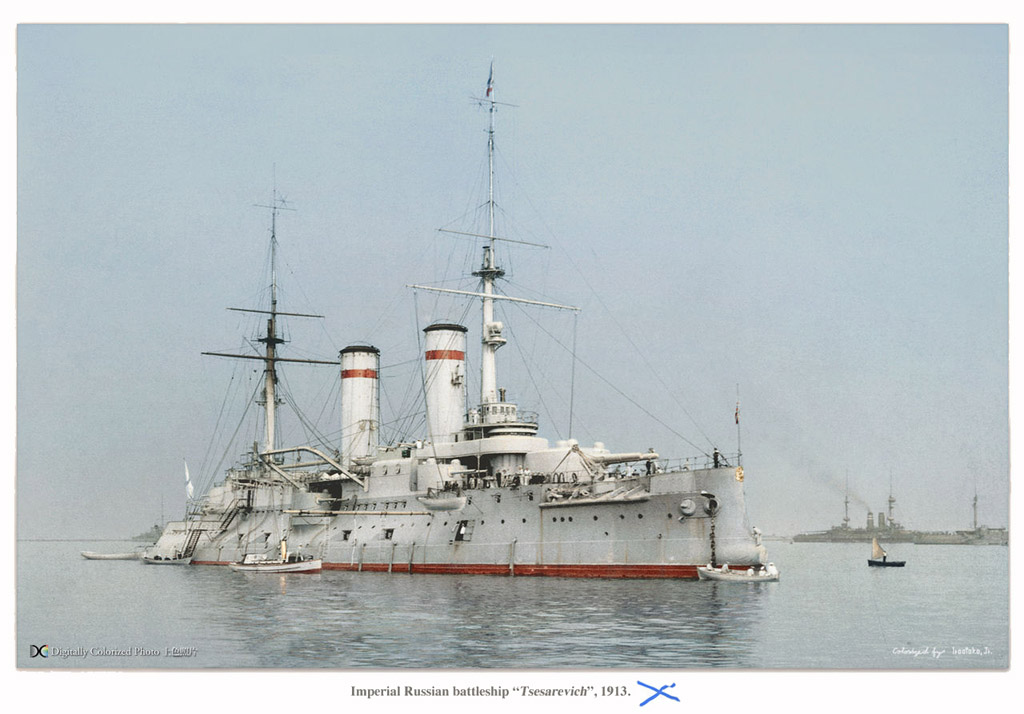
Tsesarevich in 1913 – Colorized by Hirootoko Jr.
Nothing special is reported from her service in the Baltic, at some point she received two 37 mm AA guns. However on 16 March 1917 her crew mutinied, following the February Revolution in Saint Petersburg. She was later renamed Grazhdanin on 13 April 1917. However the new Revolutionary government was still at war with Germany, and the Grazhdanin participated in the Battle of Moon Sound in October 1917 off Estonia. She damaged German minesweepers during that time, but was soon engaged by SMS König and Kronprinz. Both fired at first too far, but this was also to scare the captain who ordered a retreat. In December 1917 she was in Kronstadt, and was captured by the control of the Bolsheviks. Hulked, she stayed there to rot until 1923. Officially discarded, she was at least broken up in 1924, but not stricken before 1925.
Tsesarevich specifications |
|
| Dimensions | 118.5 x 23.2 x 7.9m (388 x 76 ft x 26 ft) |
| Displacement | 13,106 long tons (12,900 t) standard |
| Crew | 79 +778 |
| Propulsion | 2 shafts TE engines, 20 Cyl. boilers, 12,300 ihp |
| Speed | 18 knots (33 km/h; 21 mph) (20 knots as designed) |
| Range | 5,500 nmi (10,200 km; 6,300 mi) at 10 knots |
| Armament | 4 x 305 (2×2), 6 x 152, 20 x 75 mm, 20 x 47 mm, 8 x 37 mm, 6 x 381 mm |
| Armor | Waterline belt: 160–250 mm (6.3–9.8 in), Decks: 40–50 mm (1.6–2.0 in), Turrets, barbettes: 250 mm (9.8 in), CT: 10 in (254 mm) |
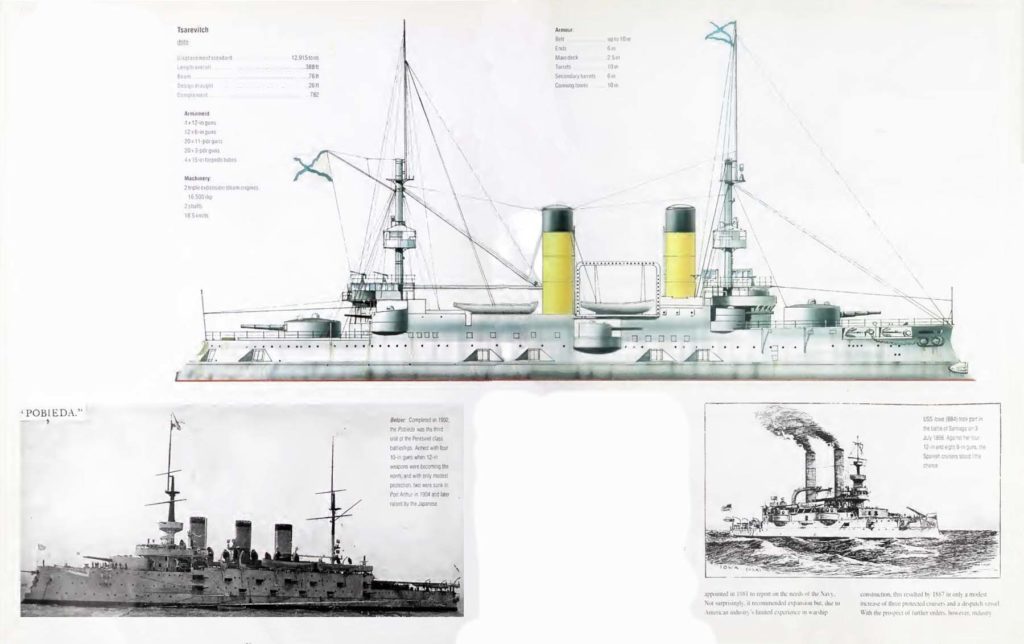
Profile of the Tsesarevich (weapons and warfare)
Sources
Conway’s all the world’ fighting ships 1860-1905
https://en.wikipedia.org/wiki/Russian_battleship_Tsesarevich
https://laststandonzombieisland.com/2014/11/page/4/
https://weaponsandwarfare.com/2018/10/28/imperial-russia-battleship-tsesarevich/


 Latest Facebook Entry -
Latest Facebook Entry -  X(Tweeter) Naval Encyclopedia's deck archive
X(Tweeter) Naval Encyclopedia's deck archive Instagram (@navalencyc)
Instagram (@navalencyc)





 French Navy
French Navy Royal Navy
Royal Navy Russian Navy
Russian Navy Armada Espanola
Armada Espanola Austrian Navy
Austrian Navy K.u.K. Kriegsmarine
K.u.K. Kriegsmarine Dansk Marine
Dansk Marine Nautiko Hellenon
Nautiko Hellenon Koninklije Marine 1870
Koninklije Marine 1870 Marinha do Brasil
Marinha do Brasil Osmanlı Donanması
Osmanlı Donanması Marina Do Peru
Marina Do Peru Marinha do Portugal
Marinha do Portugal Regia Marina 1870
Regia Marina 1870 Nihhon Kaigun 1870
Nihhon Kaigun 1870 Preußische Marine 1870
Preußische Marine 1870 Russkiy Flot 1870
Russkiy Flot 1870 Svenska marinen
Svenska marinen Søværnet
Søværnet Union Navy
Union Navy Confederate Navy
Confederate Navy Armada de Argentina
Armada de Argentina Imperial Chinese Navy
Imperial Chinese Navy Marinha do Portugal
Marinha do Portugal Mexico
Mexico Kaiserliche Marine
Kaiserliche Marine 1898 US Navy
1898 US Navy Sovietskiy Flot
Sovietskiy Flot Royal Canadian Navy
Royal Canadian Navy Royal Australian Navy
Royal Australian Navy RNZN Fleet
RNZN Fleet Chinese Navy 1937
Chinese Navy 1937 Kriegsmarine
Kriegsmarine Chilean Navy
Chilean Navy Danish Navy
Danish Navy Finnish Navy
Finnish Navy Hellenic Navy
Hellenic Navy Polish Navy
Polish Navy Romanian Navy
Romanian Navy Turkish Navy
Turkish Navy Royal Yugoslav Navy
Royal Yugoslav Navy Royal Thai Navy
Royal Thai Navy Minor Navies
Minor Navies Albania
Albania Austria
Austria Belgium
Belgium Columbia
Columbia Costa Rica
Costa Rica Cuba
Cuba Czechoslovakia
Czechoslovakia Dominican Republic
Dominican Republic Haiti
Haiti Hungary
Hungary Honduras
Honduras Estonia
Estonia Iceland
Iceland Eire
Eire Equador
Equador Iran
Iran Iraq
Iraq Latvia
Latvia Liberia
Liberia Lithuania
Lithuania Mandchukuo
Mandchukuo Morocco
Morocco Nicaragua
Nicaragua Persia
Persia San Salvador
San Salvador Sarawak
Sarawak Uruguay
Uruguay Venezuela
Venezuela Zanzibar
Zanzibar Warsaw Pact Navies
Warsaw Pact Navies Bulgaria
Bulgaria Hungary
Hungary

 Bundesmarine
Bundesmarine Dutch Navy
Dutch Navy Hellenic Navy
Hellenic Navy Marina Militare
Marina Militare Yugoslav Navy
Yugoslav Navy Chinese Navy
Chinese Navy Indian Navy
Indian Navy Indonesian Navy
Indonesian Navy JMSDF
JMSDF North Korean Navy
North Korean Navy Pakistani Navy
Pakistani Navy Philippines Navy
Philippines Navy ROKN
ROKN Rep. of Singapore Navy
Rep. of Singapore Navy Taiwanese Navy
Taiwanese Navy IDF Navy
IDF Navy Saudi Navy
Saudi Navy Royal New Zealand Navy
Royal New Zealand Navy Egyptian Navy
Egyptian Navy South African Navy
South African Navy






























 Ukrainian Navy
Ukrainian Navy dbodesign
dbodesign
Tsesarevich at Port Arthur in 1904. By then she has been repaitned with black hull and superstructures picture is from battleship Borodino